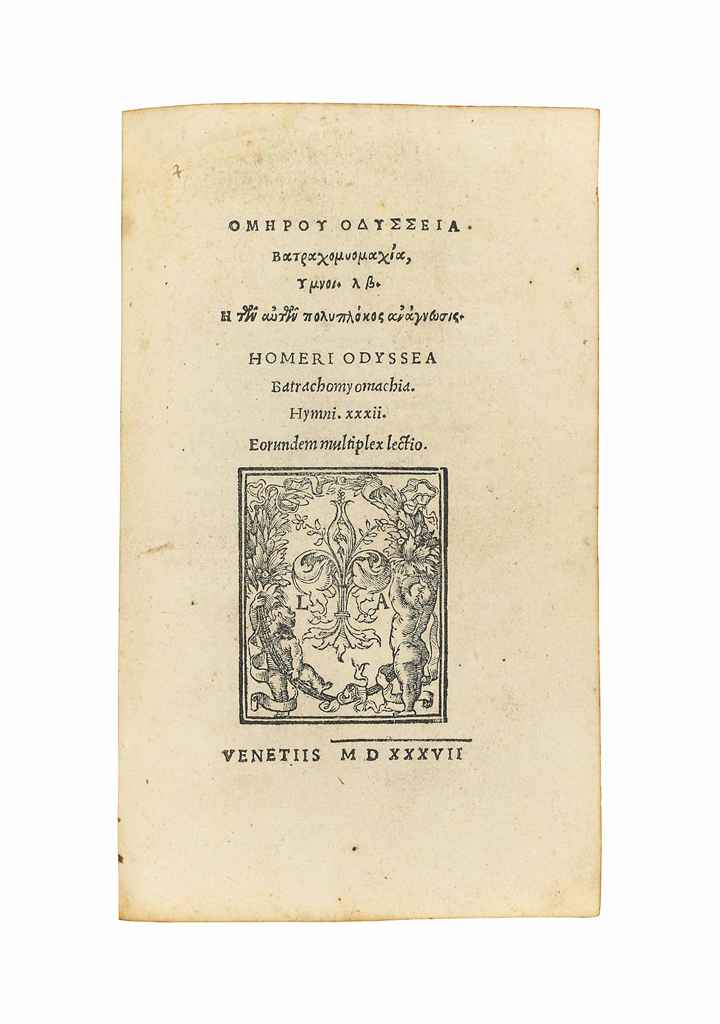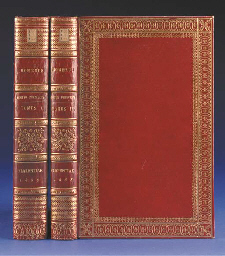HOMER (? 8th century B.C.). Opera , in Greek. Edited by Demetrius Chalcondylas (Athens 1423-Milan 1511). Florence: [Printer of Virgil (C 6061), perhaps Bartolommeo di Libri, and] Demetrius Damilas for the brothers Bernardus and Nerius Nerlius (with the financial support of Giovanni Acciaiuoli), 9 December 1488 [but not published before 13 January 1488/89, date of the dedication]. 2 volumes, median 2 o (318 x 204/202 mm). Collation: [Vol. I:] A-D 8 E 1 0 (A1r Bernardo Nerli's dedicatory letter to Piero de' Medici in Latin, A1v editor's preface in Greek, A3r Herodotus' life of Homer, B1r Plutarch's life of Homer, E7v Dio Cassius' oration on Homer, E9v-10 blank); 2A-Z ET 8 8 (Iliad). 249 leaves (of 250, without blank E10). [Vol. II:] AA-ZZ 8 ETET 6 (AA1r Odyssey, XX2r Batrachomyomachia, XX6r Hymns to Apollo, ETET5v colophon in Greek, ETET6 blank). 189 leaves (of 190, without final blank). 39 lines. Types: text 121Gk (recast by Damilas on a larger body, with the addition of a few sorts, from the same matrices as Paravisinus type 1:117Gk), dedication 96R (Di Libri type 1), signatures 110R (Printer of Benignus type 1). 10-, 8-, 3- and 2-line initial spaces. Contemporary foliation in Vol. II. (Restoration to first leaf, fols. 2D7, 6-8, LL3, LL5, and a few others, very slightly affecting text in places, LL4 remargined, discreet marginal repairs to approximately 40 leaves, a few closed marginal tears, one or two touching text, washed and pressed with occasional residual staining or discoloration.) Early 19th-century French red straight-grained morocco, gold-tooled in the style of Bozérian, covers with border of drawer-handle and small foliate tools framing a small floral roll-tool, corner squares with 4-part design of repeated gothic arch and fleur-de-lis tools, spines elegantly tooled and lettered in gold in 6 compartments with 5 false raised bands, board edges and turn-ins gilt, gilt edges, marbled endleaves (slight wear to joints and extremities, a few scrapes to covers, front inner hinge of vol. 1 split). Provenance : contemporary marginalia (largely washed) and headlines designating books by letters of the Greek alphabet, later pagination in volume I -- Graf von Dietrichstain, given in 1679 to -- Klagenfurt, Jesuits (ex dono inscription on first leaf [faded]) -- Viscount Mersey (Bignor Park booklabels, shelf-mark labels on spines). EDITIO PRINCEPS of all texts, with the exception of the Batrachomyomachia , first printed at Brescia or Ferrara ca. 1474 in a Greek-Latin edition of which a single copy survives. THE MOST IMPORTANT FIRST EDITION OF A GREEK CLASSICAL TEXT, and the most ambitious piece of Greek printing until the Aldine Aristotle. The edition was the work of the Greek scholar Demetrios Chalcondylas, who emigrated to Italy at the invitation of Cardinal Bessarion in 1447 and came under the patronage of Lorenzo de' Medici in the 1470s. In his preface Chalcondylas discusses the editorial problems posed by the corrupt state of the available manuscripts for the Homeric Hymns and the Batrachomyomachia . While copy-text for the epics was more satisfactory, Chalcondylas states that he was obliged to work his way through the monumental 12th-century commentary of Eustathius in order to correct uncertain readings. For the type of the Homer, "the first type of genuinely Hellenic character" (Proctor), Chalcondylas turned to Demetrius Damilas, a Cretan scribe of Milanese parentage, whose skill and efforts are praised in the dedication and the colophon. Damilas appears to have based the design on the hand of his fellow scribe Michael Apostolis. An earlier casting of Damilas' font had been used for the first Milanese Greek printing: Lascaris' Erotemata , the first book printed entirely in Greek, printed in 1476 by Dionysius Paravisinus, and Bonus Accursius' editions of Aesop and Crastonus (ca. 1478). The correct imprint of the edition has been the object of controversy. Proctor assigned the edition to the press of Bartolommeo di Li
HOMER (? 8th century B.C.). Opera , in Greek. Edited by Demetrius Chalcondylas (Athens 1423-Milan 1511). Florence: [Printer of Virgil (C 6061), perhaps Bartolommeo di Libri, and] Demetrius Damilas for the brothers Bernardus and Nerius Nerlius (with the financial support of Giovanni Acciaiuoli), 9 December 1488 [but not published before 13 January 1488/89, date of the dedication]. 2 volumes, median 2 o (318 x 204/202 mm). Collation: [Vol. I:] A-D 8 E 1 0 (A1r Bernardo Nerli's dedicatory letter to Piero de' Medici in Latin, A1v editor's preface in Greek, A3r Herodotus' life of Homer, B1r Plutarch's life of Homer, E7v Dio Cassius' oration on Homer, E9v-10 blank); 2A-Z ET 8 8 (Iliad). 249 leaves (of 250, without blank E10). [Vol. II:] AA-ZZ 8 ETET 6 (AA1r Odyssey, XX2r Batrachomyomachia, XX6r Hymns to Apollo, ETET5v colophon in Greek, ETET6 blank). 189 leaves (of 190, without final blank). 39 lines. Types: text 121Gk (recast by Damilas on a larger body, with the addition of a few sorts, from the same matrices as Paravisinus type 1:117Gk), dedication 96R (Di Libri type 1), signatures 110R (Printer of Benignus type 1). 10-, 8-, 3- and 2-line initial spaces. Contemporary foliation in Vol. II. (Restoration to first leaf, fols. 2D7, 6-8, LL3, LL5, and a few others, very slightly affecting text in places, LL4 remargined, discreet marginal repairs to approximately 40 leaves, a few closed marginal tears, one or two touching text, washed and pressed with occasional residual staining or discoloration.) Early 19th-century French red straight-grained morocco, gold-tooled in the style of Bozérian, covers with border of drawer-handle and small foliate tools framing a small floral roll-tool, corner squares with 4-part design of repeated gothic arch and fleur-de-lis tools, spines elegantly tooled and lettered in gold in 6 compartments with 5 false raised bands, board edges and turn-ins gilt, gilt edges, marbled endleaves (slight wear to joints and extremities, a few scrapes to covers, front inner hinge of vol. 1 split). Provenance : contemporary marginalia (largely washed) and headlines designating books by letters of the Greek alphabet, later pagination in volume I -- Graf von Dietrichstain, given in 1679 to -- Klagenfurt, Jesuits (ex dono inscription on first leaf [faded]) -- Viscount Mersey (Bignor Park booklabels, shelf-mark labels on spines). EDITIO PRINCEPS of all texts, with the exception of the Batrachomyomachia , first printed at Brescia or Ferrara ca. 1474 in a Greek-Latin edition of which a single copy survives. THE MOST IMPORTANT FIRST EDITION OF A GREEK CLASSICAL TEXT, and the most ambitious piece of Greek printing until the Aldine Aristotle. The edition was the work of the Greek scholar Demetrios Chalcondylas, who emigrated to Italy at the invitation of Cardinal Bessarion in 1447 and came under the patronage of Lorenzo de' Medici in the 1470s. In his preface Chalcondylas discusses the editorial problems posed by the corrupt state of the available manuscripts for the Homeric Hymns and the Batrachomyomachia . While copy-text for the epics was more satisfactory, Chalcondylas states that he was obliged to work his way through the monumental 12th-century commentary of Eustathius in order to correct uncertain readings. For the type of the Homer, "the first type of genuinely Hellenic character" (Proctor), Chalcondylas turned to Demetrius Damilas, a Cretan scribe of Milanese parentage, whose skill and efforts are praised in the dedication and the colophon. Damilas appears to have based the design on the hand of his fellow scribe Michael Apostolis. An earlier casting of Damilas' font had been used for the first Milanese Greek printing: Lascaris' Erotemata , the first book printed entirely in Greek, printed in 1476 by Dionysius Paravisinus, and Bonus Accursius' editions of Aesop and Crastonus (ca. 1478). The correct imprint of the edition has been the object of controversy. Proctor assigned the edition to the press of Bartolommeo di Li















Testen Sie LotSearch und seine Premium-Features 7 Tage - ohne Kosten!
Lassen Sie sich automatisch über neue Objekte in kommenden Auktionen benachrichtigen.
Suchauftrag anlegen